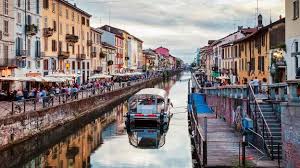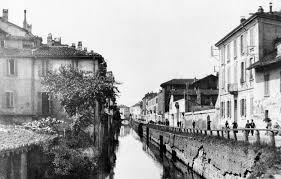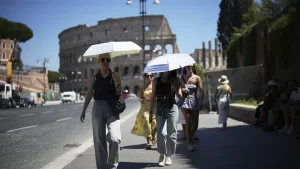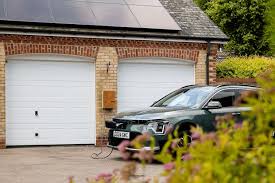Milan: Italy’s lost city of canals

Milan: Just before Italy’s second lockdown in November 2020, the banks of Milan’s Grand Canal were busy with people. Bargain hunters picked their way through market stalls, browsing tables of retro telephones, haphazard rows of art deco furniture and racks of vintage clothing.
Others sat in the cafes, sipping aperitivi or coffee, gazing out at the shoppers. The clear water of the canal reflected the dazzling autumn sunshine.
The vision is a blue streak snaking through the centre of Milan – a river fit for a major city
This is a familiar scene in Milan’s Navigli district on the last Sunday of every month, when the city’s 400-stall antiques market takes over. In this bohemian chunk of Italy’s financial capital, the austere blocks of the city centre make way for pastel-coloured houses, cobblestone canal pathways and bridges. I strolled among the mask-clad shoppers, trying to eke out some normality amid Milan at its most casual.

Located in the city’s south-west corner, the Navigli district remains one of the last true connections the Milanese have with water. The Grand Canal (Naviglio Grande) itself dates back to 1177, making it one of the oldest navigable canals in Europe. Today, it’s packed with bars, cafes, restaurants, art galleries and boutiques; in non-lockdown times, it’s a lively meeting spot or a place for a gentle passeggiata stroll by the water.
Think of almost any major inland city and there’s a big river to go with it. London has the Thames. Paris, the Seine. Berlin was built around the banks of the Spree. Yet, Milan, one of the wealthiest cities in Europe, has none. So, the city had to make one for itself. Between the 12th and 17th Centuries, a network of navigli (canals) was developed in order to grow the landlocked city’s wealth and influence. By the end of the 15th Century, Milan’s canal system connected the city to the River Ticino (25km to the west) and the River Adda (35km to the east). At the network’s heart, the Cerchia Interna (The Inner Ring) and a series of smaller channels knitted the whole thing up.
Most of the last traces of this network can be seen in Navigli, and in the north of the city, at the Martesana canal. The rest fell victim to modernisation during the mid-20th Century; as automobiles and trains replaced boats as the fastest modes of transport, The Inner Ring was buried under concrete. For the most part, the canals are still there, covered over by new roads and buildings. Some vestiges still remain in the city centre, such as the Incoronata Lock at the end of Via San Marco. Today, the lock is a curious sight: two sets of large wooden gates, frozen slightly open, useless without water, in the middle of Milan.
When I first visited Milan in 2013, I was instantly struck by Navigli. Back then, I remember being charmed by the slow-paced waterside lifestyle, far removed from the frenetic city centre. Unlike Italy’s other great cities, there is no ancient Centro Storico district in Milan, but Navigli felt like a different sort of old town. It wasn’t until I returned last year, this time to live, that I realised the significance of the canals and saw the growing movement to re-open the rest of these historical channels. There was a new energy around Navigli, and it was flowing from the Darsena.
The Darsena (meaning “dock” or “shipyard”) sits at the meeting point of two of Milan’s last canals, Naviglio Grande and Naviglio Pavese. Once one of the busiest ports in Italy until it was decommissioned during the rapid urbanisation of the 1960s, this harbourside area was nothing more than overgrown swamp on my initial visit. It lay largely unused until 2015, when it was completely renovated for the Milan Expo. Now, in place of bare concrete and overgrown weeds, a thriving urban lagoon, surrounded by cafes, bars, local businesses and a market hall, fills its formerly unloved space.
At first, however, the Milanese were sceptical of the dock’s re-opening, according to Mirta Oregna, a rower from Canottieri San Cristoforo, a local club on the Naviglio Grande. “In the beginning there was a lot of ‘why are they doing this?’. But the market that has been built there has become very popular. It’s filled with interesting shops and specialist butchers. There are two bars, which are fantastic. You sit down and you’re on the sea of Milan,” she said.
Oregna spends more time than most on the canals. Usually, she trains during the day, rowing towards the Darsena. It takes her right through the heart of the Navigli district, which she says has blossomed since the re-opening of the lagoon. The Darsena and the canals, just like Milan’s famous Duomo, have now become an attraction in their own right. People visit Milan to see them, she said.
Boat tourism has also flourished since the Darsena’s opening, with yearly passengers doubling since 2015. From spring until late summer, barges ferry tourists up and down the Grand Canal, docking in the Darsena, where they linger for an Aperol or negroni by the water.
The Navigli district remains one of the last true connections the Milanese have with water
Historically, the Darsena was a key piece of Milan’s canal network; an inland dock used to transport goods. In fact, right up until 1920, it was used to help build Milan’s most iconic building, the Duomo.
“Imagine great boats coming to Milan, [bringing] the marble to build the cathedral. The symbol of Milan,” said Edo Bricchetti, a local historian and member of Inland Waterways International. Over a period of six centuries, the distinctive pink-streaked marble was shipped from the caves of Candoglia, near Lake Maggiore more than 90km away, to the city, he explained. Using the Daresna, the boats were able to sail into the city centre.
Today, the Darsena provides a vital lung in a city infamous for its pollution. Every day, people stroll around its banks or sit with a takeaway cocktail from the nearby bars – an increasingly common sight during the pandemic. Kayakers glide over its glassy waters; fishermen teach their grandkids the patient art of angling; while runners trace loops around the boardwalk. Its success and ongoing popularity long after the Expo have led to an incredibly ambitious project to completely re-open Milan’s Inner Ring.
After a lengthy consultation process that ended in 2019, a project was finally announced to re-open the 8km stretch of canal from Cassina di Pomm in the north of the city to the Darsena in the south, effectively retracing Milan’s medieval central canal system and seeing freshwater flow through Milan for the first time in half a century. Currently, designs are being drafted for an underground tunnel to allow the water to pass through the city centre – it is hoped that the project could be completed by 2026 when Milan is set to co-host the Winter Olympics with Cortina d’Ampezzo.
“We have to see the re-opening as a big project for redeveloping the city. It will help the Milanese to live better. No pollution, no smog, no traffic,” said Federico Bianchino, a local tour guide and member of Riaprire i Navigli, an organisation dedicated the renovation of the navigli.
The vision is a blue streak snaking through the centre of Milan – a river fit for a major city – and Bianchino believes such a project will not only improve the city’s infrastructure but improve life for its inhabitants, creating much-needed spaces within the congested city centre. The recent news that Utrecht has just reopened one of its historical canals has given the Milanese added cause for optimism. Similar to Milan, the Dutch city’s circular waterway was covered over in the 20th Century in a bid to “modernise” Utrecht.
The next big hurdle for the project is funds. It’s estimated that re-opening the Inner Ring will cost €500m, which is yet to be raised. There’s hope, however, that despite coronavirus’ economic impact on Italy, the crisis may actually kickstart the process. During the hardest parts of pandemic, the Darsena and the Naviglio Grande were temporarily cleared of cafes and bars. In their absence, the canal paths became urban parks; places to walk, run, cycle and escape the confines of home. On those grounds, a proposal has been submitted to use some of the coronavirus crisis recovery funds Italy is set to receive from the EU for the project, and a leading Milanese engineering firm has been tasked with developing new plans to re-open the canals.
As dusk dropped over the city and the last stalls packed up their wares, I left the antiques market and walked around the Darsena. The fishermen were still there, patiently willing the fish to bite. A lone kayaker made his way through the stone arch that leads to the Grand Canal. The banks were dotted with people, some sitting together, others on their own enjoying the cool night air. Most nights, the scene is the same: people converging here for one reason or another, drawn to the calm, still water. Hopefully soon, more of Milan will be able to enjoy something similar, and the city will have its river once again.





